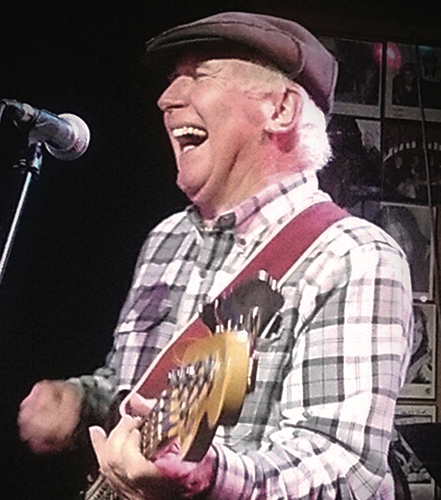By Brenna Wiegand
Michael Husser is approaching 60 years as a professional bass guitar player, but he’s been entertaining as long as he can remember.
For his high school graduation in 1964, Husser asked for an electric guitar to accompany himself and better his odds with the opposite sex.
Yet, upon starting guitar lessons, he discovered that, due to an earlier injury, the little finger of his left hand did not work sufficiently to pull down a guitar string, leaving him with just three fingers on a six-string fretboard.
“My teacher played bass in a well-known local group,” Husser said. “He suggested I trade in my guitar for an electric bass, gave me two lessons and I started playing.”
Opportunities for musicians in the 1960s abounded in California’s Bay Area, especially for a talented player who practiced three or four hours every day, teaching himself by listening to records.
“…so I got pretty good pretty quick,” he said. “Three years out of high school I ended up playing bass for Little Richard. We were always laughing and joking around on stage.”
In Santa Cruz he caught the attention of folk singer Buffy St. Marie, who invited him to make an album with her, which they recorded in December 1968 at the legendary Troubadour in West Hollywood, where he met another lifelong friend, Hoyt Axton.
Husser was there when the world-famous Mesa/Boogie guitar amplifier came into being.
“I was in a band in the ’60s and our drummer, Randy Smith, was fixing guitar amplifiers because we didn’t have any money,” Husser said. “He figured out a way to be able to sustain the notes and make any sound you wanted without having to turn the amplifier way up.”
The “Boogie” part of the name came after Smith invited local artist Carlos Santana to try out one of Smith’s amplifiers. Santana said it “really boogies” and he became the first artist to use it.
In Santa Cruz, fellow bass player Howard Dumble was at work on a bass amplifier and Husser had the third one he built.
“Howard passed away two years ago and now Dumble amplifiers sell for around $150,000, if you can get one,” Husser said. “It’s what Stevie Ray Vaughn [used].”
Husser played the blues with John Nady, who invented the first wireless guitar and handheld microphone system, for which he received a Technical Emmy Award.
He helped a friend build a recording studio in Albuquerque.
“I got paid in recording time, so I was in the studio playing, arranging and helping him write songs,” Husser said. “From there I heard about a TV station that needed somebody to do audio for the news.
“I started in 1971 at KOB-TV for $2 an hour as a broadcast engineer,” he said. “I wanted to learn everything and before long I was doing audio, camera, lighting, directing, sets – the whole thing – and they made me a director in 14 months.”
He continued ascending to larger networks, ending up at NBC Burbank where he spent 15 years editing shows that included The Tonight Show, Days of Our Lives, The Gong Show, three Super Bowls and the Hallmark Hall of Fame… “whatever they gave me.”
When a friend from NBC invited Husser to his wedding he suggested Husser bring along his bass.
“I show up and in walks Doc Severinson from The Tonight Show – I couldn’t believe it,” Husser said. “We did jazz standards and they invited me to play with them any time I wanted.”
General Electric bought the network in ’92 and started making cuts. Husser’s sisters, both teachers, suggested he go back to school. He graduated from University of California Berkeley in 1999 with a degree in American Studies and taught high school social studies for the next five years.
Husser got to a point where he was ready for a change, and in 2012 he moved from the Bay Area to Scotts Mills, Oregon, where a high school classmate had lived for several years.
Here, he has produced six albums, writing, arranging, hiring musicians and booking the studio, and even designs his own album covers. Oregon is a constant source of inspiration for the songwriter, whose process comes through observation.
“‘Oregon Rain’ came to me on the way to Scio,” Husser said. “I could see the rain coming across from the mountains and a chorus came into my head, ‘Oregon rain, Oregon rain, from the sky to the mountains and back again.’ We pulled over and I typed it into my phone.”
Husser ended up performing that song for both houses of the Oregon legislature.
“Oregon is such a beautiful place; I’ll just drive around and let it permeate me,” Husser said. “It relaxes me and opens avenues of creativity.”
“I ended up being surrounded by what I’d call creatives who wrote their own songs and had dreams and were always exploring,” Husser said. “They trusted me with their songs and in turn showed me the process so I could improve my own songwriting.
“In those circles, your job is to really enhance and support that dream and let them know you have no doubt they can do it,” Husser said.
Husser considers it a privilege to pass on that type of encouragement to the next generation, whether in the classroom or at a jam session with less experienced musicians.
“That could be the one that goes home and really works on it and comes back with a hit song,” Husser said. “I’ve seen people blossom.”
These days Husser is a multi-subject substitute teacher at Silverton High School, where students still talk about the rock and roll jam sessions he fostered.
He is working on a book about his experiences, is considering making an educational video on the bass, still plays at various venues. And, another album is in the works…
